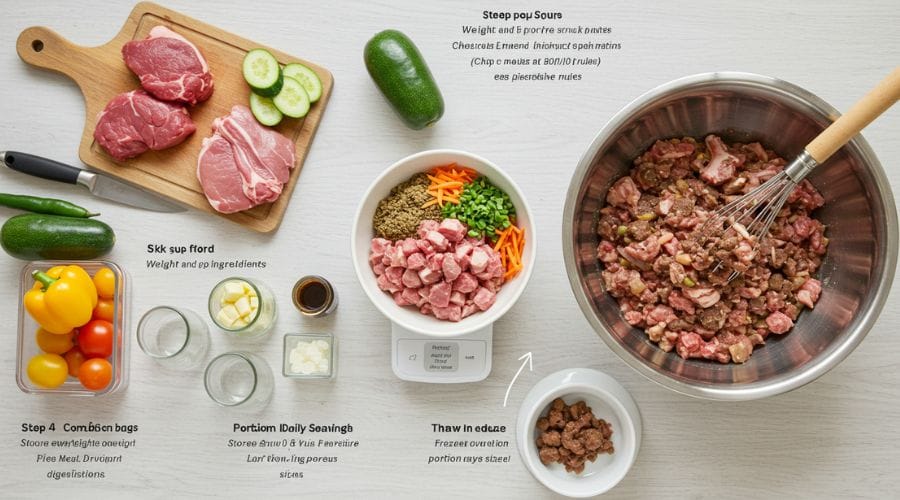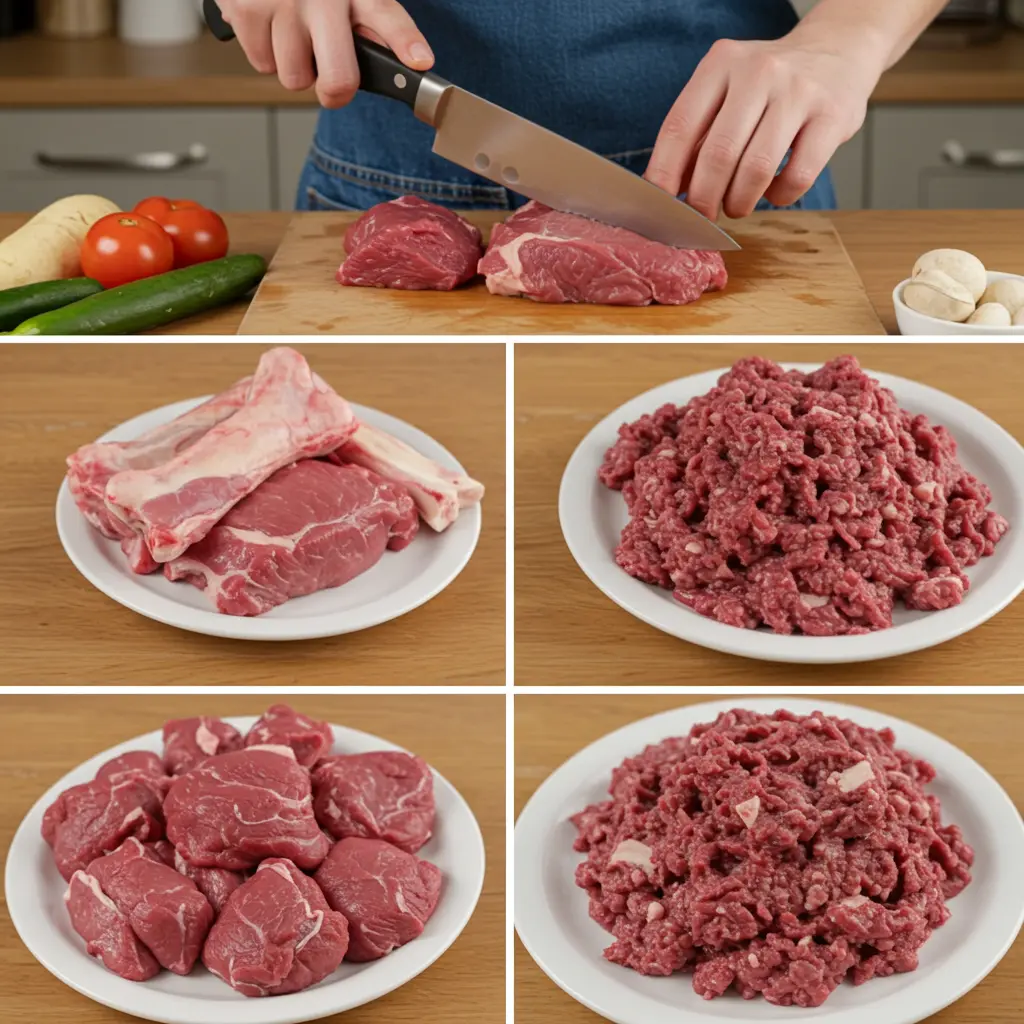Your Question is: [How to Make Raw Dog Food at Home]
Making raw dog food at home can be a rewarding way to ensure your furry friend gets a healthy and balanced diet. To get you started, here’s a simple guide:
Ingredients:
Muscle Meat: Chicken thighs, ground beef, or turkey.
Raw Meaty Bones: Chicken wings or necks (ensure they’re raw and not cooked).
Organ Meat: Liver, kidney, or heart (essential for vitamins and minerals).
Vegetables: Spinach, carrots, or pumpkin (pureed or finely chopped).
Supplements: Salmon canned in oil (for omega-3), seaweed mix (for iodine), and vitamin E oil.
Steps:
Prepare the Ingredients:
Chop or grind the muscle meat and organ meat.
Include raw meaty bones for calcium and dental health.
Add pureed or cooked vegetables for fiber and nutrients.Mix and Portion:
Combine all ingredients in the right proportions. A common ratio is 80% muscle meat, 10% bone, and 10% organ meat.
Divide the mixture into individual servings based on your dog’s size and calorie needs.Store Properly:
Use airtight containers or freezer bags to store the portions.
Keep them in the freezer and thaw them as needed.Serve and Monitor:
Feed your dog twice a day and monitor their digestion and overall health.
For more detailed dog food recipes and tips, you can explore resources like Dogs Naturally Magazine or Running to the Kitchen. Always consult your vet to ensure the diet meets your dog’s specific nutritional needs!
Why Raw? Understanding the Philosophy Behind the Bowl
The raw food movement for dogs is rooted in a simple idea: Canines thrive on a diet that mirrors what their ancestors ate in the wild. That means fresh meat, bones, and organs—not kibble cooked at high heat and packed with fillers.
While commercial dog food is convenient, it’s often a nutritional compromise.[How to make a raw food diet for dogs] Homemade raw diets put you in control, allowing you to choose high-quality ingredients and tailor meals to your dog’s unique health needs.
But before diving in, let’s get the basics right—and bust a few myths while we’re at it.
Safety First: Debunking Raw Food Myths
Myth 1: Raw Food Is Dangerous
Fact: Raw food, when handled properly, is no more dangerous than prepping raw chicken for your own dinner. Salmonella and E. coli risks are mitigated by:
Using fresh, human-grade meat
Practicing good kitchen hygiene
Freezing portions to kill off potential parasites
Myth 2: Dogs Can’t Digest Bones
Fact: Dogs can safely consume raw bones—never cooked bones. Raw bones are pliable and digestible, rich in calcium and phosphorus.
Myth 3: It’s Impossible to Balance at Home Raw
Fact: With research and a little math, you can balance raw meals. Tools like nutrition calculators, meal plans, and vet-approved consultations help keep you on track.
The Nutritional Blueprint: What Dogs Need
Creating a balanced raw diet is all about macronutrient balance and micronutrient diversity. Here’s a proven formula many raw feeders follow:
80% muscle meat: The main source of protein and energy.
10% organ meat (half of this should be liver): Organs supply essential vitamins like A, D, E, K, and B-complex.
10% raw bone: For calcium, phosphorus, and dental health.
Optional 5-10% vegetables/fruits: Adds fiber, antioxidants, and phytonutrients.
Supplements (as needed): Vitamin E, omega-3s (from fish or fish oil), kelp (iodine), zinc, and probiotics.
Pro Tip: Avoid over-supplementing. Stick to evidence-backed nutrients based on your dog’s age, size, and activity level.
Your DIY Raw Dog Food Shopping List
Proteins (Rotate Weekly):
Chicken thighs, drumsticks, wings
Ground beef or bison
Turkey necks or wings
Pork shoulder
Duck or lamb (occasional)
Organ Meats:
Liver (beef, chicken, pork)
Kidney
Heart
Spleen (optional)
Bones:
Chicken necks, wings
Duck feet
Lamb ribs (small dogs)
Veggies:
Pumpkin (great for digestion)
Spinach, kale
Carrots
Zucchini
Broccoli (in small amounts)
Supplements:
Canned salmon or sardines (in water)
Vitamin E oil (1 IU per lb body weight daily)
Kelp/seaweed powder (iodine)
Ground flax or chia (fiber and omega-3s)
A Step-by-Step Guide: How to Make Raw Dog Food at Home

Step 1: Sanitize Your Workspace
Use separate cutting boards for meat and veggies.
Clean the tools with hot soapy water or a vinegar solution.
Step 2: Weigh and Prep Ingredients
Use a kitchen scale.
Portion ingredients based on weight ratios (80/10/10 rule).
Chop or grind meat and organs.
Puree or finely chop veggies for easy digestion.
Step 3: Combine and Mix Thoroughly
In a large mixing bowl or tub, combine all ingredients.
Ensure even distribution of meat, bones, and supplements.
Step 4: Portion Into Daily Servings
Store in airtight containers or freezer bags.
Label with dates and portion sizes.
Freeze everything except the next two days’ worth.
Step 5: Serve It Up
Thaw in the fridge overnight.
Serve at room temperature.
Always clean your dog’s bowl after each meal.
Bonus Tips: Optimizing Your Dog’s Raw Diet
1. Rotate Proteins Weekly
To avoid allergies and ensure micronutrient diversity, don’t feed just chicken every day. Switch it up with beef, turkey, and pork.
2. Monitor Poop (Seriously!) of How to make a Raw Food Diet For Dogs
Firm, well-formed stools are a sign of balance. Too hard? Reduce bone. Too soft? Add pumpkin or fiber.
3. Watch for Allergies or Intolerances
Symptoms include itching, licking paws, and loose stool. One by one, remove new ingredients to isolate the issue.
4. Feed According to Weight & Activity
An adult dog generally needs 2-3% of their body weight in food per day. Adjust based on whether they’re a couch potato or a canine athlete.
Special Considerations: Puppies, Seniors, and Medical Needs
Puppies:
Need more calcium and calories.
Feed 3-4 times a day.
Use a puppy-specific raw food plan. Balance is critical in this stage.
Senior Dogs: How to Make Your Own Raw Dog Food at Home
Might need less protein but more omega-3s.
Watch for dental issues—opt for ground bone instead of whole.
Dogs with Health Conditions:
Always consult a vet if your dog has:
Kidney or liver disease
Pancreatitis
Food allergies or intolerances
Work with a canine nutritionist for tailored plans.
Science Speaks: Why Vets Are Coming Around to Raw
While some vets were once skeptical, more are embracing raw feeding, especially holistic and integrative vets. Peer-reviewed research supports raw feeding for:
Shinier coats
Better dental health
Improved energy levels
Reduced allergy symptoms
Smaller, less smelly stools
Raw diets also avoid preservatives, artificial flavors, and grain fillers common in commercial kibble.
Real-life case Studies (Inspired by Verified Sources)
Case Study 1: Buddy the Boxer
Issue: Chronic skin allergies, flaky coat.
Solution: Transitioned to a raw diet with fish, turkey, and low-carb veggies.
Outcome: Within 8 weeks, Buddy’s coat improved, and scratching was reduced by 90%.
Case Study 2: Luna the Labrador
Issue: Overweight and lethargic.
Solution: Switched to portion-controlled raw meals, reduced starches.
Outcome: I lost 10 lbs in 3 months, and my energy levels bounced back.
Sample Raw Meal Plan (For a 50-lb Dog)
| Day | Protein | Bone | Organs | Veggies | Extras |
|---|---|---|---|---|---|
| Mon | Ground turkey | Turkey neck | Beef liver | Pumpkin | Vitamin E |
| Tue | Chicken thigh | Chicken wing | Chicken heart | Spinach | Sardines |
| Wed | Ground beef | Duck feet | Pork kidney | Zucchini | Kelp powder |
| Thu | Lamb shoulder | Lamb rib | Beef liver | Carrot | Probiotic |
| Fri | Pork loin | Pork rib | Beef heart | Broccoli | Salmon oil |
| Sat | Duck | Duck wing | Chicken liver | Kale | None |
| Sun | Fasting or bone broth only (optional) | — | — | — | — |
Conclusion of How to Make Raw Dog Food at Home
Feeding raw is more than a trend—it’s a commitment to your dog’s lifelong health. It gives you control, eliminates guesswork, and turns mealtime into medicine.
Yes, it takes a little time and a bit of math. But the payoff? A happier, healthier, shinier, more energetic best friend.
Start small, learn as you go, and don’t be afraid to consult the pros.
Frequently Asked Questions (FAQs)?
Q1. Is raw food really better than kibble for dogs?
Ans. Yes, raw food can be better than kibble for many dogs because it more closely mimics a natural canine diet. It’s rich in unprocessed proteins, enzymes, and nutrients that support better digestion, shinier coats, improved energy, and smaller stools.
Unlike many commercial kibbles, raw food is free from fillers, additives, and heat-damaged nutrients. However, it’s essential to balance the raw diet properly and consult your vet, especially if your dog has health issues.
Q2. Can I make raw dog food at home without a grinder?
Ans. Absolutely! You can make raw dog food without a grinder by purchasing pre-ground meats or chopping ingredients with a knife. Use soft, raw meaty bones like chicken wings or necks that don’t require grinding. Vegetables can be finely chopped or pureed in a blender.
Just be sure all parts of the meal are portioned according to the 80/10/10 rule (meat/bone/organ), and include any essential supplements.
Q3. What’s the best meat to start with when switching my dog to a raw diet?
Ans. Chicken is the best starter protein for most dogs new to raw food. It’s lean, easy to digest, and cost-effective. Begin with chicken thighs, wings, or ground chicken with bones. Once your dog adjusts well, you can start rotating in other proteins like beef, turkey, or lamb to provide variety and prevent nutrient gaps.
Q4. How much raw food should I feed my dog daily?
Ans. Most adult dogs eat 2–3% of their body weight in raw food per day. In general, a 50-lb dog would require 1 to 1.5 pounds of food per day. Seniors may require slightly fewer supplies than puppies or active breeds. It’s best to monitor weight and energy levels and adjust portions accordingly.
Q5. Can I feed my dog raw food every day?
Ans. Yes, dogs can eat raw food every day as long as the meals are balanced over time. Raw feeding promotes long-term health benefits, such as better coat condition, healthier gums, and improved energy. Make sure you rotate proteins, include organ meats, and use supplements like fish or vitamin E to meet nutritional needs. Consistency and balance are key!

